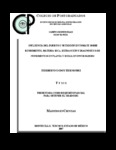| dc.contributor.author | Godoy Hernández, Heriberto | es |
| dc.creator | GODOY HERNANDEZ, HERIBERTO; 47427 | |
| dc.date.accessioned | 2012-09-09T23:03:47Z | |
| dc.date.available | 2012-09-09T23:03:47Z | |
| dc.date.issued | 2007 | es |
| dc.identifier.uri | http://hdl.handle.net/10521/1624 | |
| dc.description | Tesis (Maestría en Ciencias, Edafología).- Colegio de Postgraduados, 2007. | es |
| dc.description.abstract | En México la superficie de tomate (Lycopersicon esculentum Mill.) bajo invernadero ha crecido en forma acelerada. La mayor parte se cultiva en suelo, sin embargo su manejo genera serios problemas de patógenos en la raíz. Una tecnología amigable con el medio ambiente es el uso de portainjertos resistentes a los patógenos del suelo. Es de esperar que esta técnica de producción con plantas de mayor sistema radicular, provoque una mayor exploración del suelo que eventualmente se traduzca en una mayor eficiencia para tomar los nutrimentos, para lo cual es necesario hacer uso del monitorio nutrimental. Esto permite conocer el estado de nutrición de la planta y considerar la cantidad de fertilizante a aplicar y con ello disminuir el impacto al medio ambiente. Para comprobar esta hipótesis, se realizó un estudio donde se evaluó el efecto del uso de injerto y tres niveles de suministro nutrimental sobre el rendimiento de fruto y sobre varios parámetros de acumulación de materia seca, absorción nutrimental, concentración de macronutrimentos en la hoja más recientemente madura (HMRM), en el extracto celular de pecíolo (ECP) y en el extracto de pasta saturada. El estudio se realizó en un ciclo de 248 días. Los resultados muestran que aunque el injerto no incrementó el rendimiento comercial, si aumentó el vigor de las plantas, lo que se reflejó en una mayor longitud del tallo total (6%), área foliar (10%), área foliar específica (5%) y producción de materia seca en hoja (12%), tallo (11%) y total de la parte aérea (9%). El injerto afectó la precocidad y produjo frutos de mayor calibre (4%), pero también incrementó los frutos deformes debido al exceso de vigor. La planta injertada mostró mayor extracción de todos los nutrimentos, sobre todo una mayor eficiencia en la absorción de K. El portainjerto mostró 5% más concentración de K en la parte aérea en la HMRM, un 7% en ECP y 21% menos de concentración en Mg en la HMRM de las plantas injertadas.________There has been an accelerated growth of green house surface for tomatoes (Lycopersicon esculentum Mill.) in Mexico. Most use soil but this type of management has caused serious problems of root pathogens. The use of rootstock resistant to soil pathogens is an environment-friendly technology. It is expected that this production technique with plants of larger root systems, should induce more soil exploration which eventually will translate to more efficient nutrient up-take. A monitoring system is necessary as it indicates the nutritional condition of the plant, allowing the determination of fertilizer quantities required and thus reduces their impact on the environment. To test his hypothesis, a study on the effect of grafting and three nutritional regimens on yield, dry matter accumulation and nutrient absorption was carried out. The effect of monitoring nutrient concentration in the most recent mature leaf (MRML), in the extract of petiole cells (ECP) and in the saturated paste extract during the crop cycle was also studied. The study was done in a cycle of 248 days. Although the commercial yields were not raised, the results of the study showed increased vigor in the plants as reflected by increase in height (6%), leaf area (10%), specific leaf area (5%) and dry matter production in leaves, stems and the total of the aerial part (9%). Grafting caused early maturing and produced fruits of a higher caliber (4%), but also more deformed fruit because of increased vigor. The grafted plants had higher concentrations of all nutrients and showed more efficiency in the absorption of K. The rootstock used produced highest concentration of K in the aerial parts, 5% in MRML, 7% in ECP and 21% less in the average concentration of Mg than the grafted plants. | es |
| dc.description.sponsorship | CONACYT | es |
| dc.language.iso | spa | es |
| dc.rights.uri | http://creativecommons.org/licenses/by-nc-nd/4.0 | |
| dc.subject.ddc | Maestría | |
| dc.subject.ddc | Edafología | |
| dc.title | Influencia del injerto y nutrición en tomate sobre rendimiento, materia seca, extracción y diagnóstico de nutrimentos en planta y suelo, en invernadero | es |
| dc.type | Tesis | es |
| Tesis.contributor.advisor | Alcántar González, Ernesto Gabriel | es |
| Tesis.contributor.advisor | Castellanos Ramos, Javier Zaragoza | es |
| Tesis.contributor.advisor | Sandoval Villa, Manuel | es |
| Tesis.contributor.advisor | Muñoz Ramos, José de Jesús. | es |
| Tesis.subject.nal | Tomate. | |
| Tesis.subject.nal | Nutrición de las plantas. | |
| Tesis.subject.nal | Injerto. | |
| Tesis.subject.nal | Nutrientes. | |
| Tesis.subject.nal | Invernaderos. | |
| dc.type.conacyt | masterThesis | |
| dc.identificator | 6 | |
| dc.contributor.director | ALCANTAR GONZALEZ, ERNESTO GABRIEL; 7119 | |


